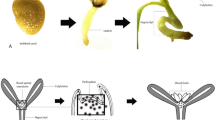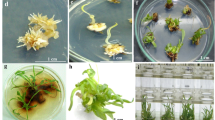Abstract
The process of galanthamine and related alkaloids production by Leucojum aestivum shoot culture in a temporary immersion system was studied. It was established that temporary immersion approach is prospective for development of a biosynthetic process for obtaining valuable Amaryllidaceae alkaloids. Both immersion frequency and temperature had significant effect on biomass accumulation and the yields of galanthamine and related alkaloids. The maximal yield of galanthamine was achieved at the cultivation of L. aestivum shoot culture in temporary immersion RITA® system at immersion frequency 15 min flooding and 8 h stand-by periods, at 26 °C. Data on the relationships in the biological system “Nutrient medium–L. aestivum shoot culture–galanthamine” are presented as well.




Similar content being viewed by others
References
Gabrielsen, B., Monath, T. P., Huggins, J. W., Pettit, G. R., Groszek, G., Hollingshead, M., et al. (1992). Antiviral (RNA) activity of selected Amaryllidaceae isoquinoline constituents and synthesis of related substances. Journal of Natural Products, 55, 1569–1581.
Pettit, G. R., Pettit, G. R., III, Groszek, G., Backhaus, R. A., Doubek, D. L., Barr, J., et al. (1995). Antineoplastic agents, 301. An investigation of the Amaryllidaceae genus Hymenocallis. Journal of Natural Products, 58, 756–759.
Luttmann, E., Linnemann, E., & Fels, G. (2002). Galanthamine as bis-functional ligand for the acetylcholinesterase. Journal of Molecular Modeling, 8, 208–216.
Sweeney, J. E., Puttfarcken, P. S., & Coyle, J. T. (1989). Galanthamine, an acetylcholinesterase inhibitor: A time course of the effect on performance and neurochemical parameters in mice. Pharmacology Biochemistry and Behaviour, 34, 129–137.
Thomsen, T., & Kewitz, H. (1990). Selective inhibition of human acetylholinesterase by galanthamine in vitro and in vivo. Life Sciences, 46, 1553–1558.
Thomsen, T., Zendeh, H., Fischer, J. P., & Kewitz, H. (1991). In vitro effects of various cholinesterase inhibitors on acetyl and butyrylcholinesterase of healthy volunteers. Biochemical Pharmacology, 41, 139–141.
Harvey, A. L. (1995). The pharmacology of galanthamine and its analogues. Pharmacy and Therapary, 68(1), 113–128.
Radicheva, N., Vydevska, M., & Mileva, K. (1996). Nivalin P-induced changes in muscule fiber membrane processes. Methods and Finding in Experimental and Clinical Pharmacolody, 18, 301–308.
Novikova, Y. U., & Tulaganov, A. A. (2002). Identification and evaluation of purity of the parent substance and medicinal form of galanthamine hydrobromide. Pharmaceutical Chemistry Journal, 36(7), 396–397.
Heinrich, M., & Teoh, H. L. (2004). Galanthamine from Snowdrop—The development of a modern drug against Alzheimer’s disease from local Caucasian knowledge. Journal of Ethnopharmacology, 92, 147–162.
Ptak, A., Tahchy, A. E., Dupire, F., Boisbrun, M., Henry, M., Chapleur, Y., et al. (2009). LCMS and GCMS for the Screening of alkaloids in natural and in vitro extracts of Leucojum aestivum. Journal of Natural Products, 72, 142–147.
Li, S. Y., Chen, C., Zhang, H. Q., Guo, H. Y., Wang, H., Wang, L., et al. (2005). Identification of natural compounds with antiviral activities against SARS-associated coronavirus. Antiviral Research, 67(1), 18–23.
Szlávik, L., Gyuris, A., Minarovits, J., Forgo, P., Molnar, J., & Hohmann, J. (2004). Alkaloids from Leucojum vernum and antiretroviral activity of Amaryllidaceae alkaloids. Planta Medica, 70(9), 871–873.
Liu, J., Hu, W. X., He, L. F., Ye, M., & Li, Y. (2004). Effacts of lycorine on HL-60 cells via arresting cell cycle and inducing apoptosis. FEBS Letters, 578(3), 245–250.
Weniger, B., Italiano, L., Beck, J., Bastida, J., Bergόnon, S., Codina, C., et al. (1995). Cytotoxic activity of Amaryllidaceae alkaloids. Planta Medica, 61, 77–79.
Berkov, S., Georgieva, L., Kondakova, V., Atanasov, A., Viladomat, F., Bastida, J., et al. (2009). Plant sources of galanthamine: Phytochemical and biotechnological aspects. Biotechnology and Biotechnological Equipment, 23(2), 1170–1176.
Pavlov, A., Berkov, S., Courot, E., Gocheva, T., Tuneva, D., Pandova, B., et al. (2007). Galanthamine production by Leucojum aestivum in vitro systems. Process Biochemistry, 42, 734–739.
Selles, M., Bergonon, S., Viladomat, F., Bastida, J., & Codina, C. (1997). Effect of sucrose on growth and galanthamine production in shoot-clumps cultures of Narcissus confusus in liquid shake medium. Plant Cells, Tissue and Organ Cultures, 49, 129–138.
Diop, M., Ptak, A., Chrétien, F., Henry, M., Chapleur, Y., & Laurain-Mattar, D. (2006). Galanthamine content of bulbs and in vitro cultures of Leucojum aestivum L. Natural Product Communications, 1(6), 475–479.
Georgiev, V., Berkov, S., Georgiev, M., Burrus, M., Codina, C., Bastida, J., et al. (2009). Optimized nutrient medium for galanthamine production in Leucojum aestivum L. in vitro shoot system. Zeitschrift für Naturforschung, 64C, 219–224.
Debnath, S. (2009). Characteristics of strawberry plants propagated by in vitro bioreactor culture and ex vitro propagation method. Engineering in Life Sciences, 9(3), 239–246.
Pavlov, A., & Bley, Th. (2006). Betalains biosynthesis by Beta vulgaris L. hairy root culture in a temporary immersion cultivation system. Process Biochemistry, 41, 848–852.
Berkov, S., Pavlov, A., Ilieva, M., Burrus, M., Popov, S., & Stanilova, M. (2005). CGC-MS of alkaloids in Leucojum aestivum plants and their in vitro cultures. Phytochemical Analyses, 16, 98–103.
Berkov, S., Pavlov, A., Georgiev, V., Bastida, J., Burrus, M., Ilieva, M., et al. (2009). Alkaloid accumulation in Leucojum aestivum in vitro cultures. Natural Product Communication, 4(3), 359–364.
Pavlov, A., & Bley, Th. (2005). Betalams biosynthests by Beta vulqans L hairy root culture in different bioreactor systems. Scientific works of University of Food Technologies, Plovdiv, Bulgaria, 52(2), 299–304.
Perez-Alonso, N., Wilken, D., Gerth, A., Jaehn, A., Nitzsche, H.-M., Kerns, G., et al. (2009). Cardiotonic glycosides from biomass of Digitalis purpurea L cultured in temporary immersion systems. Plant Cell, Tissue and Organ Cultures, 99, 151–156.
Teisson, C., Alvard, D., Berthouly, M., Cote, F., Escalant, J., Etienne, H., et al. (1996). Simple apparatus perform plant tissue culture by temporary immersion. Acta Horticulture, 440, 521–525.
Perez, A., Napoles, L., Carvajal, C., Hernandez, M., & Lorenzo, J. C. (2004). Effect of sucrose, inorganic salt, inositol, and thiamine on protease excretion during pineapple culture in temporary immersion bioreactors. In Vitro Cellular and Development Biology Plant, 40, 311–316.
Javed, F., & Ikram, S. (2008). Effect of sucrose induced osmotic stress on callus growth and biochemical aspects of two wheat genotypes. Pakistan Journal of Botany, 40(4), 1487–1495.
Eichhorn, J., Takada, T., Kita, Y., & Zenk, M. (1998). Biosynthais of the Amaryllidaceae alkaloid galanthamine. Phytochemistry, 49(4), 1037–1047.
Kim, S.-C., Kang, J.-I., Kim, M.-K., Hyun, J.-H., Boo, H.-J., Park, D.-B., et al. (2010). Promotion effect of norgalanthamine, a component of Crinum asiaticum, on hair growth. European Journal of Dermatology, 20(1), 42–48.
Pavlov, A., Georgiev, V., Marchev, A., & Berkov, S. (2009). Nutrient medium optimization for hyoscyamine production in diploid and tetraploid Datura stramonium L. hairy root cultures. World Journal of Microbiology & Biotechnology, 25, 2239–2245.
Pavlov, A., Georgiev, M., Panchev, I., & Ilieva, M. (2005). Optimization of rosmarinic acid production by Lavandula vera MM plant cell suspension in a laboratory bioreactor. Biotechnology Progress, 21, 394–396.
Acknowledgment
This research has been supported by National Science Fund of Bulgaria under contract number DO-02/105-2009.
Author information
Authors and Affiliations
Corresponding author
Rights and permissions
About this article
Cite this article
Ivanov, I., Georgiev, V., Georgiev, M. et al. Galanthamine and Related Alkaloids Production by Leucojum aestivum L. Shoot Culture using a Temporary Immersion Technology. Appl Biochem Biotechnol 163, 268–277 (2011). https://doi.org/10.1007/s12010-010-9036-7
Received:
Accepted:
Published:
Issue Date:
DOI: https://doi.org/10.1007/s12010-010-9036-7




